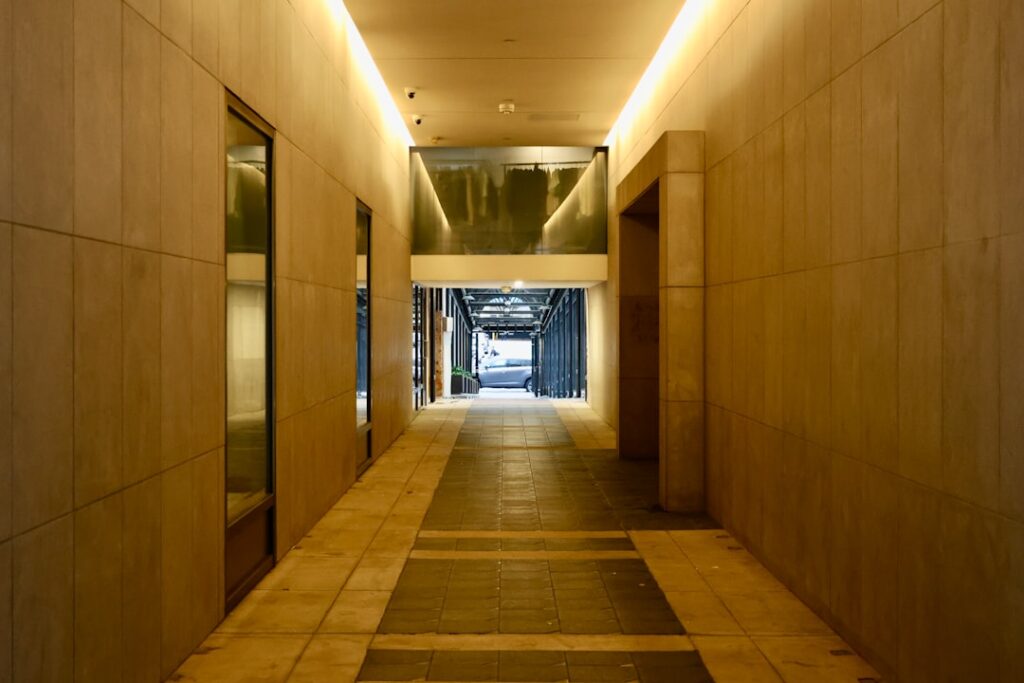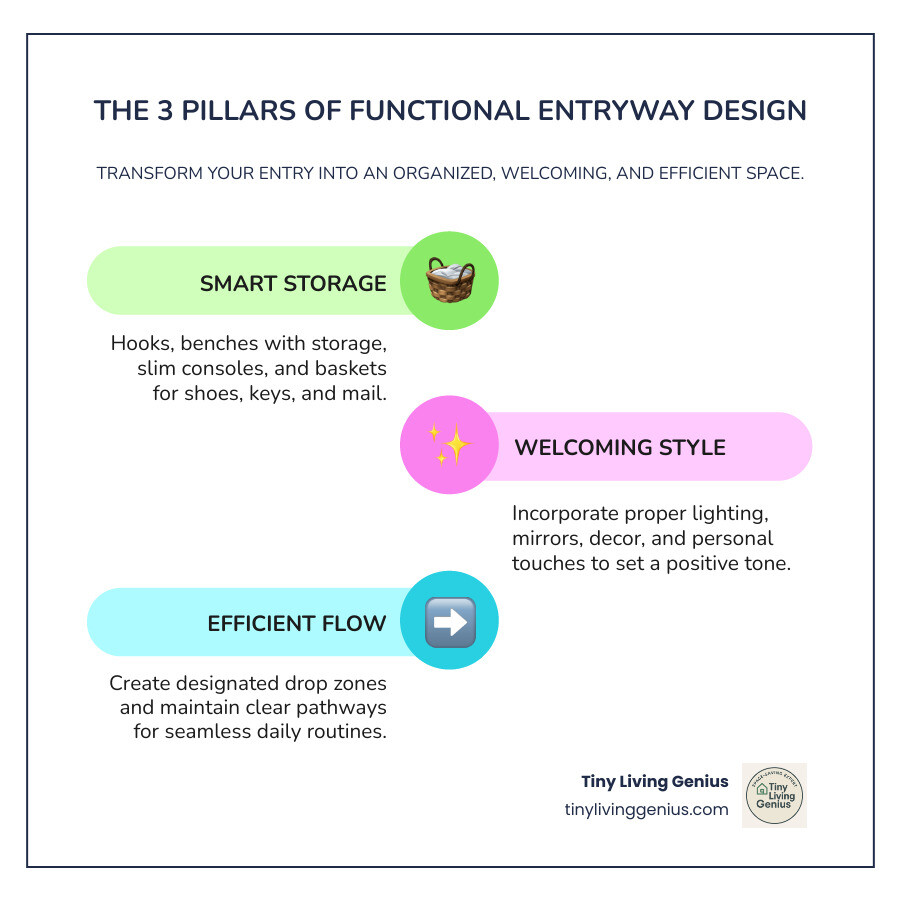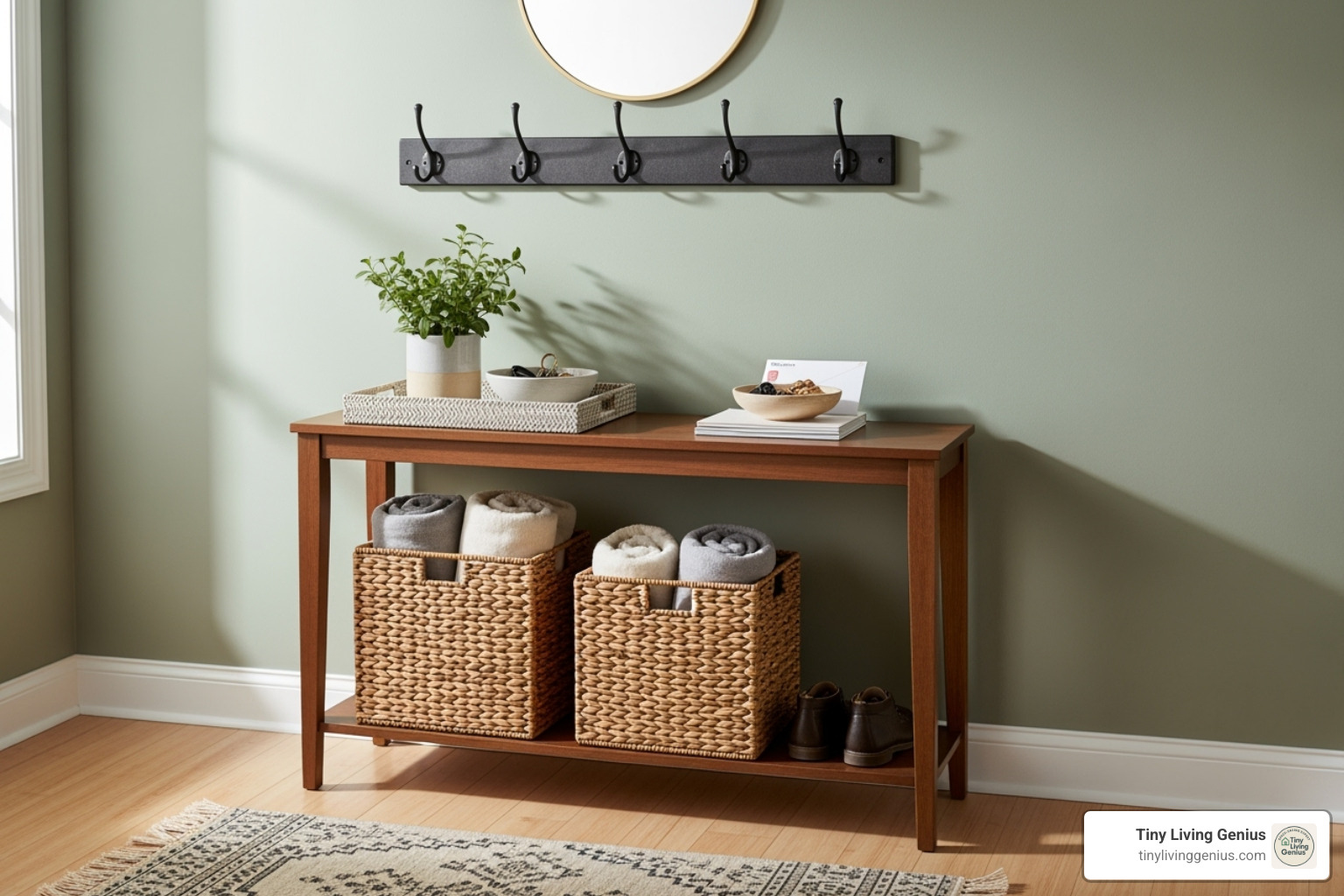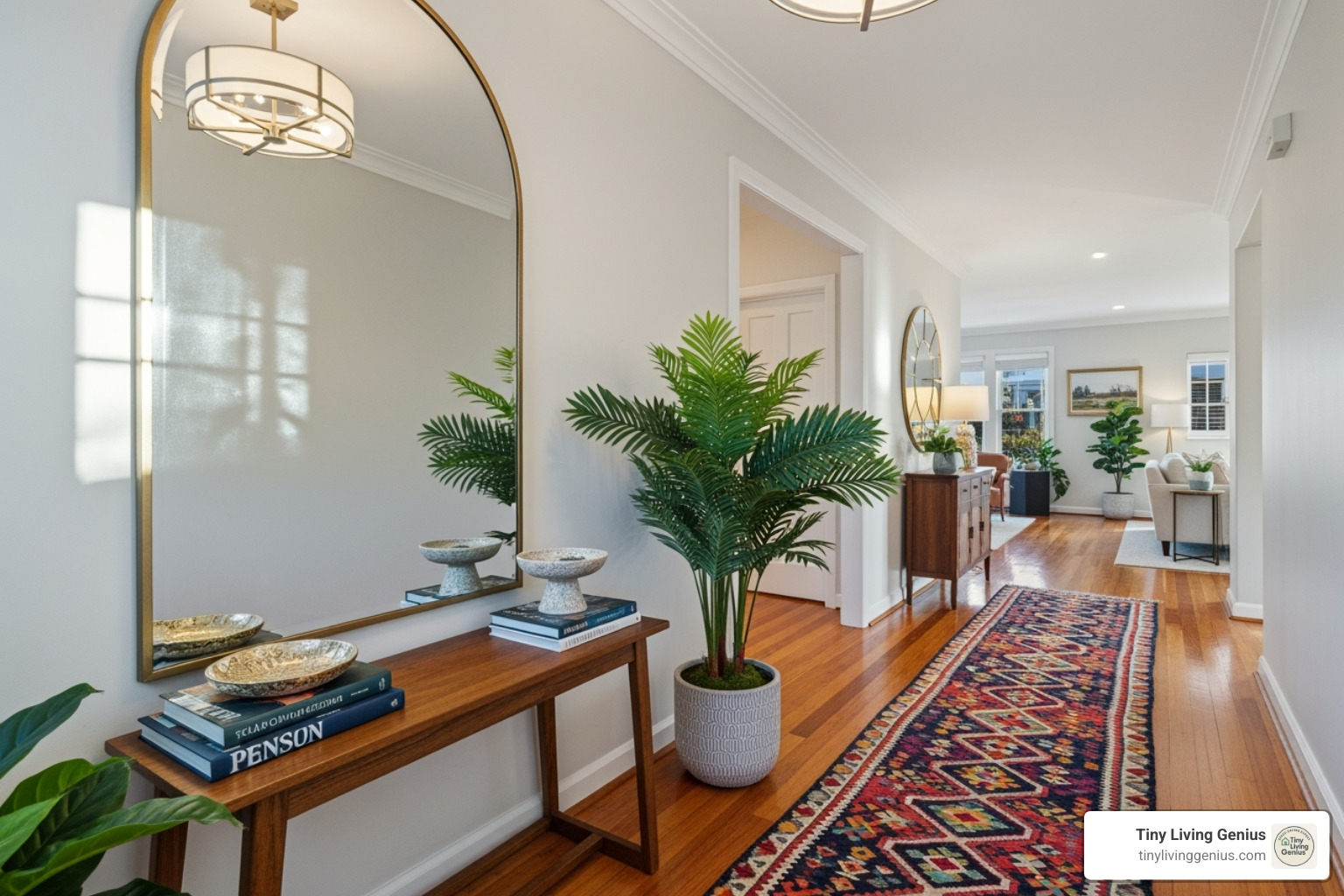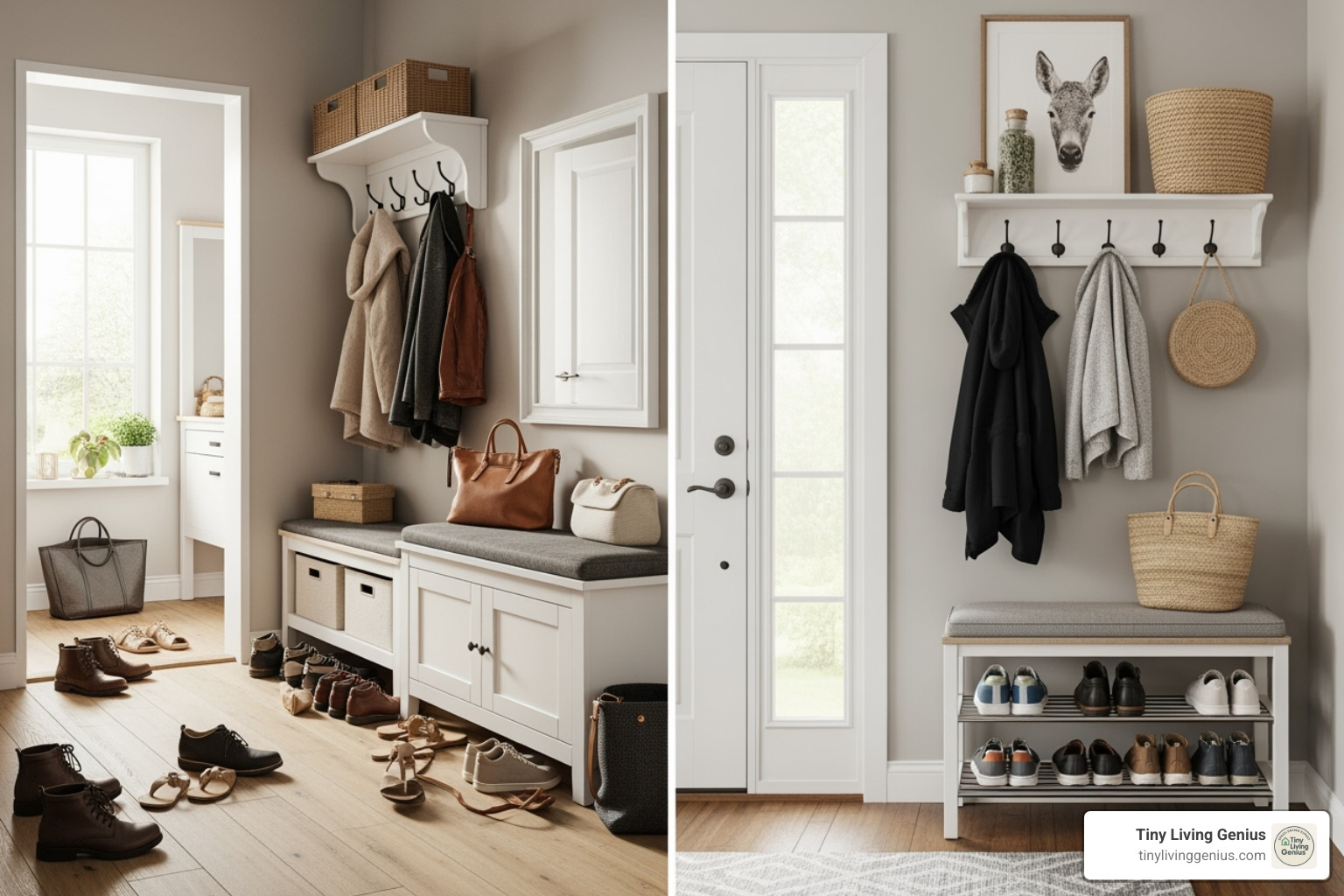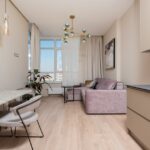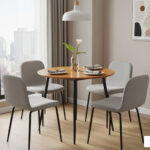Functional entryway design: Unlock 5 Genius Ideas
Why Your Entryway Deserves More Than Just a Quick Glance
Functional entryway design transforms the first space you and your guests encounter from a chaotic drop-zone into an organized, welcoming area that sets a positive tone for your entire home. Here’s what you need to create one:
Key Elements of Functional Entryway Design:
- Smart Storage: Hooks, benches with storage, slim console tables, and baskets for shoes, keys, and mail
- Organized Drop Zones: Designated spots for each person’s daily essentials
- Proper Lighting: Ambient and task lighting to guide visitors and showcase decor
- Seating: A bench or stool for putting on and taking off shoes
- Mirrors: To check your appearance and make the space feel larger
- Personal Touches: Artwork, plants, or decorative elements that reflect your style
Imagine walking through your door after a long day. Do you step into chaos—shoes scattered, coats draped over chairs, keys lost in a pile of mail? Or do you enter a calm, organized space where everything has its place?
The difference isn’t luck. It’s functional entryway design.
Your entryway is more than a passageway; it’s a transition zone between the outside world and your personal sanctuary. A cluttered entryway can increase stress, while a well-organized one creates a sense of calm that ripples through your daily routines.
For those in small apartments, this space must work harder, store more, and welcome guests—all while occupying minimal square footage. Your entryway is the home’s handshake with the world, your chance to make a statement and simplify your life.
Functional entryway design doesn’t require a grand foyer or a huge budget. It requires smart planning, multi-functional furniture, and strategic use of vertical space. Whether you’re dealing with a narrow hallway or a tiny corner, you can create an organized, stylish landing zone that works for you.
I’m Ramy Saber, a Civil Engineer and founder of Tiny Living Genius, where I specialize in helping people maximize small spaces. My background has taught me how functional entryway design can transform daily routines and create lasting first impressions in compact homes. Let me show you how to open up your entryway’s potential—no matter how small your space.
The Foundation: Planning Your Perfect Entryway
Think of designing your entryway like planning a road trip. You wouldn’t just start driving aimlessly, right? The same goes for creating a functional entryway design. Before you start shopping for furniture and decor, you need a plan.
Throwing furniture at your entryway without a strategy rarely works. You might end up with a bench that blocks your door or a coat rack that makes the space feel more cramped. Taking time to assess your space, measure carefully, and identify your main frustrations will save you money and hassle.
This planning phase is where you figure out how to make your entryway work for you. Think of it as your home’s handshake with the world—it needs to be confident and put-together. Whether you’re working with a spacious foyer or a tiny corner, the right plan transforms chaos into calm.
Define Your Entryway’s Primary Purpose
First, ask a simple question: what do you need your entryway to do?
Your entryway is a hardworking space. It’s the transition zone between the outside world and your home. It’s where you drop your bags, grab your keys, and greet guests. Understanding these roles helps you design a space that supports your daily life.
For most, the entryway must handle daily routines. This means creating a drop zone for keys, wallets, and phones—those grab-and-go items that always seem to disappear. You need spots within arm’s reach for these essentials.
Your entryway is also a guest welcome area. It’s the first thing visitors see, so it should feel inviting. A cluttered entryway sends the wrong message, while a clean, organized one makes guests feel comfortable.
Finally, think of your entryway as a storage hub. Coats, shoes, bags, and umbrellas all need designated homes. Without proper storage, they create clutter throughout your home.
The key is figuring out which purpose matters most. Do you have frequent visitors? Prioritize style and seating. Live alone? Focus on streamlining your morning routine. Have kids or pets? You’ll need durable solutions and plenty of hooks. For more ideas, check out our guide on Smart Storage Solutions for Small Spaces.
Evaluate Your Needs and Pain Points
Now, what’s actually wrong with your entryway right now?
Maybe you have a shoe pile that trips you every time you walk in. Or perhaps you’re constantly playing the “where are my keys?” game. That mail clutter on the side table keeps growing. These aren’t just minor annoyances—they’re daily sources of stress.
Your entryway should make life easier, not harder. Take a hard look at your space and identify what’s driving you crazy. Do you have no place for coats? Is there a lack of seating, forcing you to hop on one foot while putting on boots? Does the awkward layout block traffic?
Spend a few days observing how you use your entryway. What do you drop first? Where do things pile up? These pain points are your roadmap for improvement.
Grab a tape measure and note your entryway dimensions—width, depth, and ceiling height. Measure doorways and consider door swing patterns. This information is gold when you’re shopping for furniture. You’ll know exactly what will fit before you buy and can sketch out potential arrangements to see what works best.
The goal isn’t perfection. It’s creating a functional entryway design that eliminates daily frustrations. Once you know what’s broken, you can fix it with smart, targeted solutions.
Maximizing Storage: The Core of Functional Entryway Design
Here’s the truth about functional entryway design: it all comes down to smart storage. To banish daily chaos, everything needs a home. This is even more critical in compact spaces where every inch matters.
The secret is finding the right balance. We need open storage for things we grab constantly—keys, sunglasses, dog leashes. But we also need closed storage to tuck away the visual clutter that can make a small space feel overwhelming.
Smart Furniture for Functional Entryway Design
Multi-functional furniture is our secret weapon for an efficient entryway. These hardworking pieces pull double duty, saving space while boosting utility.
The console table is often the most important piece. A console with drawers offers both style and function, providing a surface for decor while hiding away mail, keys, and other essentials. Even an extra-thin console provides useful storage in a narrow space.
Storage benches are another game-changer. They offer a spot to sit while dealing with shoes and often come with built-in storage underneath—perfect for corralling shoes or bags.
For narrow hallways, slim, wall-mounted cabinets work wonders. Wall-mounted shoe cabinets offer shallow storage that doesn’t impede traffic flow, keeping footwear organized without eating up floor space.
Ottomans with hidden storage are perfect for extra seating. You can slide two ottomans under an entryway table; they’re lightweight and offer hidden storage for gloves or other small items.
A money-saving tip: you don’t need to buy all new pieces. Repurposing furniture you already own can breathe new life into your entryway. A petite dresser or chest can be transformed into an entryway table. For more innovative furniture ideas, check out our guide on Best Furniture Ideas for Small Spaces.
Go Vertical: Wall-Mounted Solutions
When floor space is limited, look up. Going vertical is an indispensable strategy for functional entryway design, as our walls are our best friends in small spaces.
There’s no such thing as too many wall hooks in a small entryway. Hooks make it easy to hang everyday purses, hats, and jackets. A slim, standalone coat rack is also a great movable alternative.
Floating shelves are fantastic for multiple purposes. They can display decor, hold bins for mail, or serve as a minimalist landing strip for keys and wallets. They keep the floor clear, making the entryway feel larger.
For maximum flexibility, a pegboard organizer with removable pegs and shelves offers incredible versatility. You can hang coats, display plants, or adjust the configuration as your needs change.
Don’t overlook over-the-door storage. For entryways without closets, these organizers provide valuable space for shoes or accessories without any installation.
You can even get creative with DIY wall treatments. A custom wood slat wall adds both functionality and a sophisticated design element. For more ideas on using vertical space, read our guide on Maximize Vertical Space in Small Spaces.
Essential Strategies for Small Space Functional Entryway Design
Designing for a small entryway requires clever strategies to ensure maximum utility without sacrificing style.
Creating a “mudroom” corner is possible even without a dedicated room. Carve out a focused area for storage using a hall tree, a bench with storage, or built-in cubbies for individual family members. A quality wood bench paired with a wall-mounted rack can serve every purpose an entry should.
Using mirrors strategically is a small entryway’s best friend. Mirrors reflect light, making the space feel larger and brighter. Positioning a mirror across from a door or window can dramatically open up a space. A large statement mirror becomes a focal point that draws the eye upward.
For compact spaces, keeping it minimal is key. Display just a few essentials and use covered storage like woven bins to keep everything else tucked away. A minimalist design with clean lines creates a calm entryway that doesn’t feel cluttered.
If you’re working with a truly tiny entryway, here are the 5 essential items: wall-mounted hooks, a slim console or shelf, a small bench or stool, a mirror, and a small rug or mat to define the space.
For a deeper dive into optimizing your compact home, explore our Tiny Apartment Design: The Ultimate Guide and our article on Smart Storage Solutions for Small Spaces.
Weaving in Style: Creating a Welcoming First Impression
Once you’ve nailed down the storage, it’s time to make your entryway beautiful. Think of your entryway as your home’s opening statement, an invitation that reflects your personality. A truly functional entryway design isn’t just about hooks and bins; it’s about creating a space that feels warm, welcoming, and uniquely yours.
The secret is to balance style with the practicality you worked so hard to build. This means thoughtfully layering lighting, color, texture, and personal touches to create an atmosphere that makes everyone happy to walk through that door.
Layered Lighting for Ambiance and Function
Good lighting transforms an entryway from a shadowy passageway into a bright, inviting space. The best approach is to layer different types of lighting.
Start with natural light whenever possible. If you have windows near your entryway, keep them uncovered or use sheer curtains to let sunshine pour in.
For ambient lighting—your main illumination—consider pendant lights or flush mounts. A clever trick is to double up on table lamps for extra brightness and a chic, symmetrical look on your console table. Another great option for renters is using plug-in wall sconces to add a fun element instead of a standard table lamp.
Don’t forget task lighting for specific activities like sorting mail. A small table lamp on your console does the trick beautifully.
Your light fixtures can also be stunning decorative statements. A bold, sculptural pendant or a neat sconce lifts the entire aesthetic. For ultimate control over the mood, install dimmer switches to adjust the brightness.
The Power of Decor, Color, and Texture
A simple formula for a balanced entryway includes something at table height (preferably with drawers), a place to sit, a mirror, a lamp or sconce, art, and possibly an umbrella holder. These elements work together to create both beauty and function.
Let’s start with mirrors. Beyond checking your appearance, mirrors are magic in small spaces. Positioning a mirror across from the door reflects natural light and opens up the entryway, making it feel more spacious. A circular brass mirror adds a modern touch, while a large black-trimmed mirror can dramatically transform a cramped hallway.
Artwork and gallery walls inject personality into what could be a purely utilitarian space. Whether it’s a single statement piece or a collection of family photos, art makes your entryway feel personal and lived-in.
Don’t underestimate the impact of a good area rug or runner. A rug defines the entryway zone, adds warmth, and protects your flooring. It’s also a fantastic opportunity to introduce color and pattern. The right rug can tie everything together.
Plants bring life, color, and a sense of calm. Place a potted plant beside your console table to add welcome texture and dimension. If you’re not confident with your green thumb, start with low-maintenance options like pothos or snake plants.
When it comes to color, create a cohesive palette that flows into the rest of your home. Soft whites and earthy tones create an inviting, serene atmosphere. But if you’re feeling bold, don’t shy away from drama! Wallpaper can add a wow factor to entryways, changing them from forgettable to unforgettable.
The real magic happens when you mix materials and textures. This layering creates visual interest and depth. Consider incorporating wood through a reclaimed console table or pegboard. Add metal accents with brass mirrors or iron hooks. Bring in fabric through colorful pillows on a bench or a velvet chair. Tile is another fantastic texture—think checkered flooring or brick-style tile in a herringbone pattern for durability and character. Finally, natural textures like woven baskets and jute rugs bring warmth and an organic feel.
The Front Door: Your Entryway’s First Statement
Before anyone steps inside, they see your front door. It’s a powerful design element that sets expectations.
The simplest way to make an impact is to choose a bold color. A bright yellow door can boost curb appeal, while a glossy black Dutch door exudes timeless sophistication. Pick something intentional that reflects your home’s personality.
Sometimes all you need is updated hardware. Swapping out tired door handles, adding a stylish knocker, or replacing old house numbers can give your entrance a fresh, polished look.
If you’re craving more natural light, consider a door with glass panels or sidelights. These allow sunshine to flood the space, making it feel brighter and more open.
Finally, make sure your front door reflects your home’s architectural style. A historic home might showcase restored woodwork, while a modern dwelling might feature a sleek, minimalist entrance. When your door matches the character of your home, the entire entryway feels more cohesive.
Common Pitfalls and Budget-Friendly Solutions
We’ve all scrolled through picture-perfect entryways on Pinterest and wondered, “Why doesn’t mine look like that?” The truth is, even well-intentioned designs can fall flat. But the good news is that avoiding common pitfalls and creating a fabulous foyer doesn’t require a designer’s budget or a complete renovation.
4 Common Entryway Design Mistakes to Avoid
The difference between an entryway that works and one that frustrates often comes down to a few missteps. Let’s talk about the most common ones so you can sidestep them.
Oversized furniture is the biggest culprit in cramped entryways. A beautiful piece that looked perfect in the showroom can make your hallway feel like an obstacle course. The solution? Always measure twice and choose slim, wall-mounted, or multi-functional pieces that provide storage without eating up floor space.
Inadequate lighting can turn an entryway from welcoming to dreary. A single overhead bulb doesn’t cut it. Dark corners make it hard to find keys and create an unwelcoming atmosphere. Think in layers—ambient lighting for brightness, task lighting for specific areas, and a decorative fixture for style.
Then there’s the problem of forgetting a “drop zone.” Without designated spots for keys, mail, and bags, clutter multiplies. Every household member needs their own spot to deposit daily essentials. When everything has a home, chaos doesn’t stand a chance.
Finally, many fall into the trap of one-size-fits-all solutions. What works in a grand foyer won’t work in a narrow apartment hallway. A family with kids has different needs than a couple without pets. The key to successful functional entryway design is customization—tailoring solutions to your specific space, lifestyle, and routines.
Thrifty Tips for a Fabulous Foyer
Now for the fun part—creating an amazing entryway without emptying your wallet. Creativity beats cash every time.
DIY shelving is one of the easiest and most affordable upgrades. Simple floating shelves cost very little and provide valuable surface area for keys or decor without claiming any floor space.
Before buying new, take a fresh look at what you already own. Repurposing furniture is both budget-friendly and smart. For example, a petite dresser can be transformed into a charming entryway console, giving a forgotten piece new life. A bedside table might be the perfect landing spot for keys and mail.
Shopping secondhand is another treasure trove. Explore thrift stores and estate sales for unique finds that add character. A vintage mirror or antique coat rack tells a story that brand-new pieces can’t match, and it’s a sustainable choice.
Never underestimate the power of a fresh coat of paint. It’s a transformative and affordable tool. A vibrant front door can change your home’s curb appeal. Inside, a serene color palette can make a cramped space feel calm and open. Consider adding entryway molding to create visual interest on plain walls—it’s a budget-friendly upgrade that looks expensive.
For renters, peel-and-stick flooring or wallpaper is a game-changer. Peel-and-stick vinyl can update tired floors with trendy patterns, and it’s completely removable. Bold wallpaper makes a significant statement without requiring extensive furniture. These temporary solutions let you experiment with style without permanent commitment.
The bottom line? A fabulous, functional entryway design requires thoughtful planning and creative problem-solving. With these strategies, you can create an entryway that welcomes you home every day without breaking the bank.
Frequently Asked Questions about Functional Entryway Design
How do I create an entryway in an open-concept home?
In an open floor plan, the secret to creating an entryway is visual zoning. Use furniture and design elements to “draw” boundaries where walls don’t exist. Place a console table or bench perpendicular to the main living area to act as an anchor, signaling “this is where the home starts.”
A rug is another powerful tool for defining the space. Choose one that contrasts with your main flooring to create a visual “room.” Strategic lighting, like a pendant or wall sconces over the entry zone, further solidifies the space.
If a sofa is near the entry, place a slim console table directly behind it. This creates a natural landing strip for keys and mail while subtly separating the entry from the living space. Add a mirror above and hooks on a nearby wall to complete your functional entryway.
What are the absolute essentials for a functional entryway if I have very little space?
When you’re working with a sliver of space, every item needs to earn its place. Functional entryway design doesn’t require square footage; it requires smart choices.
- Wall-mounted hooks are non-negotiable. They keep coats and bags off the floor and take up zero floor space.
- A slim surface, like a floating shelf or narrow console, is crucial for keys, mail, and phones.
- A mirror serves double duty: it lets you check your appearance and makes the space feel larger by reflecting light.
- Seating, such as a small stool that tucks under a console or a wall-mounted fold-down bench, is essential for putting on shoes.
- A small basket or bin for shoes keeps them corralled and out of the walking path.
For more ideas on making the most of limited space, explore our guide on Smart Storage Solutions for Small Spaces.
How can I keep my entryway organized with kids and pets?
Kids and pets bring joy and mess. With the right systems, you can maintain order without losing your mind.
The golden rule is: everything needs a designated, easy-to-access home. For kids, use a cubby system with hooks and labeled bins at their height. When children can independently manage their own belongings, they’re more likely to do it.
Durability is your friend. Choose flooring like tile or vinyl that can handle wet paws and muddy boots. Opt for patterned or darker, washable rugs that hide dirt and are easy to clean.
For pets, create a dedicated station near the door. Install a sturdy hook for leashes and keep a small bin nearby for toys and waste bags. Place a durable mat inside the door for wiping paws.
Closed storage is invaluable. Baskets, cabinets, or a storage bench with a lid keep the visual chaos contained and away from curious pets.
Finally, make a quick five-minute reset part of your evening routine—shoes in the bin, coats on hooks. When the system is simple enough for everyone to follow, maintaining order becomes second nature.
Conclusion
Think back to where we started—the chaotic pile of shoes and the frantic search for keys. Now imagine stepping into a space that works with you. That’s the power of functional entryway design.
Throughout this guide, we’ve found that smart storage solutions can tame chaos, while layered lighting and decor create a warm, welcoming atmosphere. Most importantly, strategic organization simplifies your daily routines, saving you time and mental energy.
A well-designed entryway reduces daily stress and creates a positive first impression. It’s an investment in your peace of mind—that quiet sense of calm you feel when everything has its place.
You don’t need a grand foyer or a huge budget to achieve this. Whether you’re working with a narrow hallway or just a wall in an open-concept space, the principles of functional entryway design can work for you. It’s about being intentional, choosing multi-functional furniture, and using vertical space to your advantage.
At Tiny Living Genius, we’re passionate about proving that small spaces hold immense potential. Your entryway might be compact, but with smart solutions, it can make a grand statement. We believe everyone deserves a home that works beautifully, no matter the square footage.
Ready to tackle other areas of your compact home? Explore more tiny apartment tips and tricks and continue your journey toward a more organized, stylish living space. Your entryway is just the beginning.

